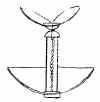|




Meanwhile:
How about a
little music?
We have a selection of tunes that were
popular during the first days of aviation, performed by Sue Keller, courtesy the
Ragtime Press:
Want to ask a question? Tell
us something? Arrange a showing of one of our airplanes? Ping:
mailto:[email protected]
| |
| One of the most
important inventions leading up to the invention of the airplane was the rubber
band-powered airplane. Really! In 1871, French scientist Alphonse
Penaud astounded members of the French Academy of Sciences by flying a
rubber band-powered aircraft he called a planaphore for 131 feet.
It was the first recorded flight of an inherently stable aircraft.
For the next 50 years, rubber band-powered (or torsion-powered)
airplanes were an important research tool for aerodynamic engineers. It
allowed them to test various configurations of wings, rudders, elevators,
and fuselages for airworthiness without having to build full-size
airplanes. |
Click on a
picture to enlarge it.

In 1871, this rubber band-powered "planaphore"
was the most advanced airplane flying. Its inventor, Alphonse Penaud, is
considered the father of aviation modeling. |
| Torsion-powered aircraft also became a popular children's
toy in the late 1800s. Almost from the moment Penaud invented the rubber
band torsion motor, toy makers were using it to power flying toys.
One of the most popular of these toys was a torsion-powered helicopter. In
1878, Bishop Milton Wright brought this toy home to his sons Wilbur
(age 12) and Orville (age 8) and started them dreaming of flight. It soon
wore out, but they made copy after copy. They were still making copies to
delight their nieces and nephews in 1903 just before they made their first
powered flights in a real airplane.
The flying models that we have included in this section were found in
the pages of Fly and other flight magazines from the
earliest days of aviation. |

In 1878, the Wright brothers' father gave them this
rubber band powered model helicopter. After it wore out, they made many
copies -- this was their first successful powered flying machine. |
- Wright
Flyer -- Designed by
Phillip McCutcheon in 1911, this model aircraft resembles a Wright
Model A with the elevator in front and the rudder in back. It
also has two contra-rotating props, just like the real thing.
|
|
| If you'd like a whole book of pioneer model aircraft, Lindsay
Publications has reprinted Harper's
Aircraft Book, a 1913 classic that not only explains the
basics of rubber-band powered modeling, it also includes plans for a
Wright Flyer, Bleriot, Curtiss, Neuport, and many others. You can purchase
the book online at http://www.lindsaybks.com/bks/aero/index.html. |
|
Amazing But True! Rubber
Band Facts
A rubber band is an extremely capable engine for an aircraft, and the
science of torsion motors for model airplanes has progressed at the same
amazing pace as gasoline and jet engines in real airplanes. Consider:
- In 1909, as Wilbur and Orville Wright were coming home from a
triumphant tour of Europe, the American record for distance flown with
a rubber band-powered airplane was just over 200 feet.
- In 1916, as World War 1 was at its height, Thomas Hall if the
Illinois Model Aero Club flew a model 5337 feet -- over a mile!
- In 1924, just a few years before Lindbergh flew the Atlantic, Robert
V. Jaros (also from the Illinois Model Aero Club) flew a model 7920
feet in 10 minutes and 14 seconds.
Today, there is a group in California getting ready to fly a
torsion-powered aircraft that will carry a man! If you'd like to
learn more about rubber band models, there's a huge organization of
enthusiasts just dying to teach you called the National Free
Flight Society. You can visit their web site at http://freeflight.org/. |

Here's something to shoot for -- this highly
detailed Wright Flyer, no bigger than your hand, actually flies! It was
built by Kazuhiro Suzuki in 1993. The rubber band cognoscenti call these
tiny torsion-powered airplanes "peanuts." This peanut happened
to win the Pioneer class of the Nagoya Nuts contest in 1993. (Before
you ask -- no, we don't know where to get the plans. But we're
looking.) |
|

